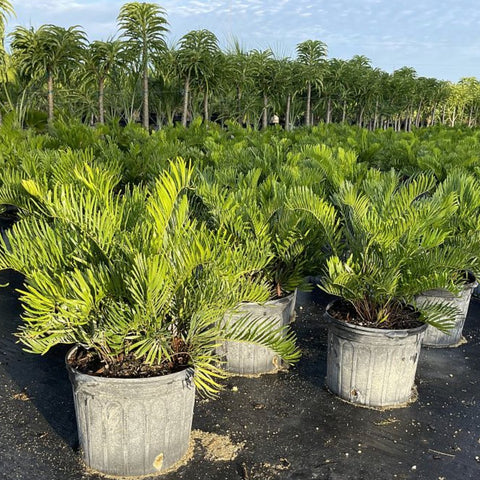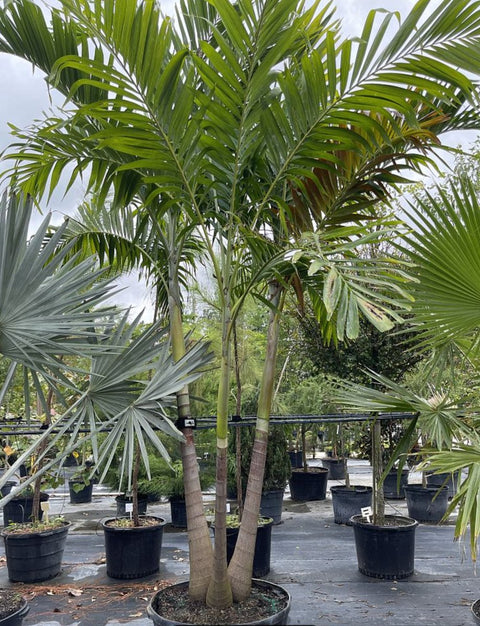coontie palm
Introduction
Indoor plants have gained immense popularity over the years due to their ability to beautify our living spaces and provide numerous benefits. One unique and attractive option to consider is the coontie palm. In this blog post, we will explore the various aspects of the coontie palm, including its background, benefits, care tips, and potential challenges. By the end, you'll have a comprehensive understanding of this beautiful indoor plant and why it's worth adding to your collection.
Overview of the Coontie Palm
The coontie palm, scientifically known as Zamia integrifolia, is a fascinating plant with a rich history. It is native to regions in Florida, Georgia, and the Caribbean. This palm is known for its unique physical appearance, featuring feathery foliage and upright growth. Its ability to thrive in different light conditions and low maintenance requirements make it an ideal choice for indoor cultivation.
Description of its Physical Appearance and Unique Features
The coontie palm boasts distinctive features that set it apart from other indoor plants. Its foliage consists of long, arching, feather-like leaves that create an elegant and tropical visual appeal. The plant can reach a height of about three to five feet, making it perfect for compact indoor spaces. Additionally, its cylindrical trunk adds to its unique aesthetic charm.
Mention its Scientific Name (Zamia integrifolia) and Native Regions
Known scientifically as Zamia integrifolia, the coontie palm is native to various regions in the southeastern United States and the Caribbean. Primarily found in Florida and Georgia, it thrives in sandy, well-draining soils, and can withstand the hot and humid climate of these areas. Its adaptability makes it a versatile choice for indoor cultivation in various regions.
Benefits and Advantages of Coontie Palm
The coontie palm offers several benefits and advantages that make it a sought-after indoor plant. These advantages include low maintenance requirements, contribution to indoor air quality, and aesthetic appeal.
Low Maintenance Requirements
The coontie palm is known for being a low-maintenance plant, making it perfect for busy individuals or those with minimal gardening experience. Its resistance to pests and diseases eliminates the need for frequent interventions. Additionally, the plant's tolerance for different light conditions allows it to thrive in various indoor environments, including both bright and low-light areas. Furthermore, the forgiving nature of the coontie palm regarding watering makes it a resilient plant that can withstand occasional neglect.
1. Discuss its Resistance to Pests and Diseases
The coontie palm exhibits natural resistance to common pests and diseases, reducing the need for frequent pesticide applications or treatments. Unlike many other indoor plants, the coontie palm is not a favorite target of insects such as scale insects or mealybugs, enabling it to maintain its health and vigor with minimal intervention.
2. Highlight its Tolerance for Different Light Conditions
One of the biggest advantages of the coontie palm is its ability to thrive in a wide range of light conditions. It can flourish in both bright, well-lit areas and low-light corners of your home. This adaptability makes it a versatile choice for various indoor environments, providing flexibility in terms of placement options.
3. Mention its Forgiving Nature Regarding Watering
Another advantage of the coontie palm is its forgiving nature when it comes to watering. While it does require consistent moisture, it can tolerate occasional under or overwatering. This makes it an excellent choice for individuals who may forget to water their plants regularly or have a busy schedule that doesn't allow for frequent monitoring.
Contribution to Indoor Air Quality
Indoor air pollution is a growing concern, but the coontie palm can help combat this issue. As a natural air purifier, this plant can filter out toxins and improve the air quality in your living spaces.
1. Explain How Coontie Palm Purifies the Air by Removing Toxins
The coontie palm has been found to effectively remove harmful toxins from the air, such as formaldehyde, benzene, and xylene. These compounds are commonly found in household products and can have detrimental effects on our health. By placing a coontie palm in your home, you can create a cleaner and healthier indoor environment.
2. Discuss its Ability to Increase Humidity in a Room
In addition to purifying the air, the coontie palm can also increase humidity in a room. This is especially beneficial during the dry winter months when indoor humidity levels tend to drop significantly. By releasing moisture through transpiration, the coontie palm helps create a more comfortable living environment and reduces the risk of respiratory issues caused by dry air.
Aesthetic Appeal
Not only does the coontie palm offer practical benefits, but it also adds a touch of elegance to any interior space. Its unique foliage and texture make it a visually appealing plant that can enhance the overall design aesthetics of your home. Additionally, it complements a variety of décor styles, making it a versatile choice for any room.
1. Mention its Unique Foliage and Texture
The coontie palm's foliage is considered one of its most distinctive features. With long, arching leaves that resemble feathers, this plant creates a dynamic and visually appealing display. Its deep green color adds a sense of freshness and vitality to any room, making it a standout element in your indoor décor.
2. Highlight its Ability to Enhance Interior Design
Whether you have a minimalist, contemporary, or tropical-themed interior design, the coontie palm can seamlessly integrate into your aesthetic vision. Its versatile appearance allows it to add a touch of nature and tranquility to any space, creating a harmonious and inviting atmosphere.
3. Discuss its Suitability for Different Décor Styles
From modern apartments to bohemian-inspired homes, the coontie palm can adapt to various décor styles, making it a versatile choice for any interior design. Its sleek and upright growth adds structure and sophistication, while its foliage brings a refreshing burst of greenery that complements different color palettes and textures.
Care and Maintenance Tips for Coontie Palm
Providing proper care and maintenance is crucial to ensure the coontie palm thrives in your indoor environment. By following these tips, you can enjoy a healthy and vibrant plant that will continue to enhance your living spaces.
Ideal Growing Conditions
The coontie palm has specific preferences when it comes to its growing conditions. By understanding and providing these requirements, you can create an environment where the plant can flourish.
1. Discuss its Preferred Temperature and Humidity Ranges
The coontie palm thrives in temperatures ranging from 70 to 90 degrees Fahrenheit. It prefers a warm and humid environment, similar to its native regions. Avoid placing the plant near drafty areas or air conditioning vents, as these can lead to temperature fluctuations and dryness.
2. Mention the Importance of Providing Well-Draining Soil
Coontie palms prefer well-draining soil to avoid waterlogged conditions that can damage their root system. A mixture of peat moss, sand, and perlite is ideal for providing a well-draining medium. This allows for proper water absorption while preventing excess moisture accumulation.
3. Suggest Suitable Placement Options (e.g., near windows, away from drafts)
When it comes to placing your coontie palm, consider its light requirements and potential exposure to drafts. While the plant can tolerate a range of light conditions, it prefers bright, indirect light. Placing it near windows where it can receive filtered natural light is ideal. However, ensure it is protected from direct sunlight, as this can scorch the foliage. Additionally, avoid placing it near drafty areas, such as open doors or vents, as this can cause stress and damage to the plant.
Watering Guidelines
Proper watering is essential for the health and vitality of your coontie palm. While it is forgiving regarding watering, it is important to provide consistent moisture without overwatering.
1. Explain the Frequency and Amount of Water Required
Water your coontie palm when the top inch of soil feels dry to the touch. This typically equates to watering around once a week. However, adjust the frequency depending on factors such as your indoor environment's humidity levels and the size of the pot. Avoid under or overwatering by ensuring the soil is consistently moist but not waterlogged.
2. Mention the Importance of Avoiding Overwatering
Overwatering can lead to root rot and other issues. To prevent this, ensure the pot has proper drainage holes to allow excess water to escape. Additionally, avoid leaving the plant sitting in standing water, as this can lead to root suffocation. Always discard any excess water that collects in the saucer or tray beneath the pot.
Pruning and Fertilization
To maintain the coontie palm's tidy appearance and promote healthy growth, occasional pruning and fertilization are necessary.
1. Discuss the Need for Occasional Pruning to Maintain a Tidy Appearance
As the coontie palm grows, older foliage may become yellow or brown and lose its aesthetic appeal. Regularly remove these dead or dying leaves to keep the plant looking neat and fresh. Pruning can also help maintain the desired size and shape of the plant. Use clean pruning shears to make clean cuts and avoid damaging the healthy parts of the plant.
2. Recommend Suitable Fertilizers and Their Application Frequency
Coontie palms benefit from regular fertilization to ensure they receive the necessary nutrients for healthy growth. Use a balanced, slow-release fertilizer specifically formulated for palms. Apply the fertilizer according to the package instructions, typically every three to four months during the growing season. Avoid overfertilizing, as this can cause nutrient imbalances and negatively impact the plant's health.
Potential Challenges and Solutions
While the coontie palm is generally a resilient plant, it may face certain challenges that can affect its health and well-being. By being aware of these challenges and implementing appropriate solutions, you can ensure your coontie palm thrives.
Common Pests and Diseases Affecting Coontie Palm
While the coontie palm is naturally resistant to many pests and diseases, it may occasionally encounter issues. Familiarize yourself with common pests and diseases that can affect this plant and learn how to address them effectively.
1. Identify Typical Pests such as Scale Insects or Mealybugs
Scale insects and mealybugs are among the common pests that can infest the coontie palm. These pests feed on the plant's sap, leading to weakened growth and visual damage. Regularly inspect your coontie palm for signs of infestation, such as sticky residue, yellowing leaves, or small insects. If you notice any pests, gently wipe or spray them with a mixture of water and mild soap. Avoid using harsh pesticides, as they can harm the plant.
2. Suggest Organic Pest Control Methods
If natural methods are not effective in controlling pests, consider using organic pest control options such as neem oil or insecticidal soap. These products are safer for the environment and can effectively eliminate pests without causing harm to the coontie palm.
Addressing Nutrient Deficiencies
Coontie palms, like any other plant, may experience nutrient deficiencies if they don't receive adequate nourishment. Recognizing the symptoms and addressing deficiencies promptly is essential for maintaining a healthy plant.
1. Discuss Symptoms of Common Nutrient Deficiencies in Coontie Palm
If your coontie palm exhibits stunted growth, yellowing or browning of leaves, or overall poor health, it may be experiencing a nutrient deficiency. Common deficiencies include nitrogen, magnesium, and potassium. Nitrogen deficiency is characterized by pale or yellow leaves, while magnesium deficiency leads to yellowing between leaf veins. Potassium deficiency may manifest as brown leaf tips or edges. Identify the specific symptoms and address the deficiency with appropriate plant food or supplements.
2. Recommend Suitable Plant Food or Supplements
To address nutrient deficiencies, use a balanced palm fertilizer with the appropriate nutrient ratios. Follow the package instructions for application frequency and amounts. Additionally, consider using organic supplements like compost or vermicompost to boost the overall health and nutrition of the plant.
Additional Tips and Recommendations
In addition to the care and maintenance tips mentioned above, here are some extra suggestions to ensure the successful cultivation and enjoyment of your coontie palm.
Compatible Plants to Pair with Coontie Palm
Consider pairing your coontie palm with other indoor plants that have similar care requirements. Companion plants can create a visually pleasing display while sharing similar environmental needs. Some compatible plants to consider include snake plants, peace lilies, or pothos.
Creative Ideas for Incorporating Coontie Palm into Home Décor
Get creative with how you incorporate your coontie palm into your home décor. Consider placing it in a decorative pot that complements your interior design style or using it as a centerpiece on a coffee table. You can also experiment with different heights by grouping multiple coontie palms together or pairing them with plants of varying heights.
Share Personal Experiences or Success Stories from other Coontie Palm Owners
Stories and experiences from other coontie palm owners can provide valuable insights and inspiration. Share anecdotes or success stories from fellow plant enthusiasts who have incorporated coontie palms into their homes. Hearing about others' experiences can help readers feel more connected to the plant and motivated to add it to their collection.
Conclusion
The coontie palm is an alluring and beneficial indoor plant that deserves a place in your collection. Its low maintenance requirements, ability to contribute to indoor air quality, and aesthetic appeal make it a standout choice for any home. By following the care and maintenance tips mentioned in this blog post, you can ensure your coontie palm thrives and continues to provide beauty and benefits. Consider adding this unique plant to your indoor space and enjoy the beauty it brings.
Thank you for reading! If you have any comments, questions, or personal experiences with coontie palms, we would love to hear from you. Leave a comment below and let's continue the conversation!
Photo Prompts:
- ('Capture the beauty and tranquility of indoor plants in this photo prompt. Imagine a cozy living room with soft, neutral tones and natural light pouring in through large windows. In the corner, showcase a unique and eye-catching coontie palm plant, its feathery fronds adding an exotic touch to the room. Complement the plant with rustic wooden furniture and pops of green in throw pillows and decor. Emphasize the serenity and warmth of this indoor oasis in high-res detail using a Sony Alpha a7 III camera with a Sony FE 24-105mm f/4 G OSS lens --ar 9:16 --v 6.0.', 'placeholder_or_error_image_path')
- ('"Visualize an enchanting garden filled with vibrant flowers and lush plants. Picture a whimsical pathway made of cobblestones, leading to a charming wooden gazebo nestled among tall trees. A cascading waterfall nearby creates a soothing soundtrack. Capture the magical ambiance and vibrant colors of this garden oasis in high-res detail using a Sony Alpha a7 III camera with a Sony FE 24-105mm f/4 G OSS lens --ar 9:16 --v 6.0."', 'placeholder_or_error_image_path')
- ('"Capture the enchanting beauty of the Coontie Palm in its natural habitat. Frame an idyllic scene of a serene coastal landscape with wild Coontie Palms swaying gently in the breeze. Highlight their glossy, fern-like fronds and distinctive cone-shaped clusters, creating a striking contrast against the golden sands and turquoise waters."', 'placeholder_or_error_image_path')






























Comments (0)
There are no comments for this article. Be the first one to leave a message!